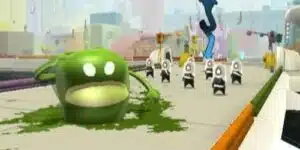
We open to an alien invasion. The colorless Graydians have attacked and enslaved Blob’s home planet. Blob is leading a revolution to bring back freedom by painting color back into his world. Like the film Pleasantville, black & white represents conformity and subservience, while color denotes freedom and individuality. Thus Blob rolls and bounces throughout the city of Chroma, defiling gray cityscapes with splashes of color, transforming mindless Graydian drones back into playful, self-aware Raydians. The plot can be quickly forgotten, and the game doesn’t try to hit you over the head with it. However, the interstitial cutscenes that flesh out the story feature genuinely funny animations that contribute to the game’s freewheeling atmosphere. These shorts could easily form the foundation for a Pixar film.
So, when your little ball of rage against the machine touches a surface, say a billboard, he colors it with whatever color he currently is. de Blob can change colors by crashing into the enemy paint canisters that litter the environment. Points are awarded based on coloring specific surfaces different colors in a given time limit, defeating enemies by attacking them with a matching color, racing to checkpoints, freeing Raydians and claiming landmarks.
These tasks are laid out like GTA‘s smaller quests. Each color corresponds to a musical instrument, the sound of which is activated as the player paints. Let’s say you’re currently colored yellow, and the music theme you’ve chosen is a woozy reggae number. The percussive elements of the song are always there, but when you paint, a trumpet rings out. As the player colorizes Chroma, the soundtrack flexes and breathes with fuller instrumentation. It’s a small touch, but it adds a lot to atmosphere. Anyway, the player eventually racks up enough points to clear the level, opening up new, unpainted districts.
de Blob is the offspring of two disparate ideas. The first may come from Tony Hawk’s Pro Skater, namely the graffiti multiplayer game. Blob splashes color onto every surface he touches — no need for Double Whammy 180 Fishtail Ollies, or whatever they’re calling them these days. It makes for a consistently gripping multiplayer game, though aimlessly painting the town red (and blue and yellow, and mixtures thereof) is a joy in itself.
The second influence is more readily apparent. In terms of style, de Blob shares the whimsical atmosphere of Katamari Damacy. They both feature a rolling, tumbling protagonist, but it’s the organic sprawl that both games share that truly set them apart. de Blob is imbued with the same sort of grinding (and I don’t mean that in a bad way), childlike Zen that Katamari perfected. Just before the player gets bored of a specific area, a new, spotless neighborhood is opened up, just begging to be sullied with a splash of color, like an immaculate subway car sashaying through the Bronx circa ’78. As the player refines his skills, so the game world opens up, revealing deeper challenges and more cunning obstacles. Everything that can be done in the game is explained within the first few minutes of play, but variations in the environment require subtle modifications of the player’s basic skill set. Each level introduces a new obstacle or enemy that presents a unique challenge.
The most entertaining moments occur within the minigames in between the story mode’s proper levels. These frantic puzzles require the player to time every jump and strategize the sequence of painting in order to get the right colors in the right places. The more imposing time demands create a wonderful urgency. This is a real highlight of the game because the designers carefully laid out each environment to encourage the player to think critically and quickly. The larger “sandbox” levels are more laid-back and even relaxing, but also definitely less fun.
de Blob will appeal to your dormant obsessive compulsive nature more than anything since Diablo. You will while away the hours in a schizophrenic haze, determined to leave no surface unpainted. Eventually every patch of gray stands out like a bleach stain on a maroon tablecloth, and you won’t be able to quit until every inch of your environment sings with color. de Blob is everything Super Mario Galaxy should have been but wasn’t. It’s a simple, seamless romp through a delightfully childish landscape.
The game could have used more variation. More enemy types and more varied quests would have been welcome. There are only four basic mission types. I would have liked to have seen a little more variety here. Also, why not incorporate the motion controls to include drawing? After all, the game is about painting. Though the head-smackingly unnecessary and even frustrating waggle functionality could easily have been left out, it’s a game that finally gets the philosophy of the Wii (at least, what that philosophy should be), and as a result, it’s one of the finest games to grace the platform yet.

